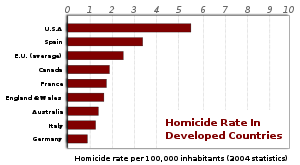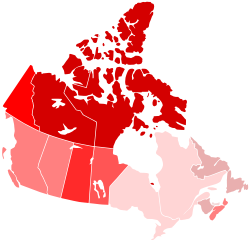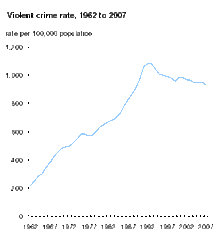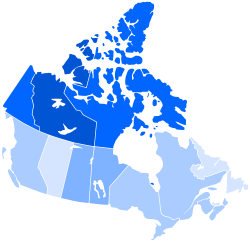- Crime in Canada
-
Under the Canadian constitution, the power to establish criminal law and rules of investigation and trying crimes is vested in the federal government. The provinces are responsible for law enforcement (although provincial policing in many jurisdictions is contracted to the federal and national Royal Canadian Mounted Police), and while the power to prosecute offences belongs to the federal government, responsibility for prosecutions is delegated to the provinces for most types of criminal offences. Laws and sentencing guidelines are uniform throughout the country, but provinces vary in their level of enforcement.[citation needed]
Contents
Statistics Canada data
There were 2,452,787 crimes reported in 2006; 48% were property related crimes and 12.6% were violent crimes. At a rate of 7,518 reported incidents per 100,000 people, the crime rate in 2006, the latest year for which there is statistics, was the lowest crime rate in twenty-five years.[1] The crime rate has been in general decline since 1991.
The province with the lowest crime rate in 2006 was for the third straight year Ontario with 5,689 per 100,000, followed by Quebec with 5,909 per 100,000. The province with the highest crime rate for the 9th straight year was Saskatchewan with 13,711 per 100,000. Regina is the city with the highest crime rate followed by its provincial counterpart Saskatoon. Quebec City, Trois-Rivières, and Saguenay have the lowest crime rates of any city and are all located in Quebec.[2] The three northern territories have higher per capita crime rates than any province.
The number of murders dropped to 594 in 2007, 12 fewer than the previous year. One-third of the 2007 murders were stabbings and another third were by firearm. In 2007, there were 190 stabbings and 188 shootings. Handguns were used in two-thirds of all firearm murders. Seventy-four youths were accused of murder, down 11 from the previous year. About eighty-four percent of murders were done by someone known to the victim. Male victims of homicide were most likely to be killed by an acquaintance, someone known to them through a criminal relationship, or a stranger. Female victims of homicide were most frequently killed by a current or former intimate partner, or another family member. The province with the highest crime rate was Manitoba while the lowest crime rates occurred in Prince Edward Island and Newfoundland and Labrador. Saskatoon has the highest murder rate at 3.6 per 100,000 people.[3]
Police reported crime rate is thought to be an under count of actual violence rates. To rectify this, approximately every five years statistics Canada conducts a survey of victimization in Canada. The last survey reported was conducted in 2004 and it found that the violent crime rate in Canada was 106 per 1,000 which is slightly lower than in 1999 when it was 111 per 1,000.[4]
Crime statistics by province and territory
Crime statistics vary considerably through different parts of Canada. In general, the eastern provinces have the lowest violent crime rates while the western provinces have higher rates and the territories higher still. Of the provinces, Saskatchewan has the highest violent crime rate.
2006 crime statistics for the provinces and territories are given below, as reported by Statistics Canada.[5] last updated: 28 February 2007
Crimes rates by offences for each province and territory, 2006 Canada N.L. P.E.I. N.S. N.B. Que. Ont. Man. Sask. A.B. B.C. Y.T. N.W.T. Nvt. rate per 100,000 population All incidents 8,269 6,571 7,486 8,698 6,781 6,626 6,251 12,325 15,276 10,336 12,564 22,197 44,074 32,831 Criminal Code offences (excluding traffic offences) 7,519 6,055 6,793 8,069 6,111 5,909 5,689 11,679 13,711 9,523 11,365 20,593 41,468 31,265 Crimes of violence 951 851 714 1,135 849 756 756 1,598 2,039 1,101 1,218 3,007 6,448 6,764 Homicide 1.9 1.4 0.7 1.7 0.9 1.2 1.5 3.3 4.1 2.8 2.5 0.0 0.0 6.5 Attempted murder 2.6 1.0 0.7 3.0 1.2 3.3 2.5 2.2 4.7 2.3 2.1 0.0 0.0 13.0 Assaults (level 1 to 3) 735 734 625 919 706 540 563 1,243 1,671 888 980 2,655 5,834 5,893 Sexual assault 68 67 48 86 67 67 56 108 125 64 75 195 373 598 Other sexual offences 9 5 11 7 18 13 5 11 15 7 10 51 55 46 Robbery 94 23 17 85 30 91 87 182 150 93 110 58 36 39 Other crimes of violence 41 20 12 34 27 40 41 48 71 44 39 48 151 169 Property crimes 3,588 2,363 3,000 3,514 2,562 3,114 2,811 4,951 4,776 4,480 5,685 5,107 6,357 4,256 Breaking and entering 768 737 537 735 599 867 541 1,074 1,228 768 1,088 1,467 2,332 1,965 Motor vehicle theft 487 131 115 263 187 507 303 1,376 633 725 682 445 927 621 Theft over $5,000 52 15 31 44 38 65 44 49 42 66 58 61 65 36 Theft $5,000 and under 1,889 1,252 2,002 1,940 1,446 1,399 1,531 2,152 2,392 2,383 3,367 2,780 2,654 1,316 Possession of stolen goods 108 34 52 233 54 43 110 88 160 188 139 77 136 140 Frauds 284 195 263 299 239 234 283 214 320 350 351 279 244 179 Other Criminal Code offences 2,980 2,841 3,079 3,420 2,700 2,039 2,122 5,130 6,896 3,942 4,462 12,479 28,664 20,246 Criminal Code offences (traffic offences) 368 279 508 328 321 415 245 284 963 490 441 974 1,393 809 Impaired driving 228 221 396 255 242 214 139 213 474 347 340 701 1,168 686 Other c.c. traffic offences 140 59 112 74 79 201 106 71 489 144 101 272 225 124 Federal statutes 383 237 186 301 349 302 317 362 602 322 758 631 1,214 757 Drugs 295 128 127 218 248 266 239 183 275 258 617 468 769 673 Other federal statutes 88 109 59 83 102 36 79 179 327 64 141 163 444 85 Guns
Main article: Gun politics in CanadaOnly one third of Canadian murders involve firearms. Most Canadian weapons are rifles or shotguns owned by rural property owners, hunters and target shooters, and are less likely to be used in crimes.[citation needed] Many types of weapons are prohibited or restricted in Canada. The two biggest provinces, Ontario and Quebec have had a long history of strict gun controls.
It is effectively illegal to carry concealed handguns in Canada. There is a permit that allows people to carry if they can prove they need to protect their lives but the permit is very rarely issued. Only about 50 permits had been issued in all of Canada as of 2000. In the same year there were approximately 1 million hand guns in Canada, compared to 77 million in the United States.[6] However, defensive use of firearms in Canada is much more common than many would like to believe.[7]
Canada has more guns and fewer controls on them than most nations in Western Europe (exceptions being Finland, Norway and Switzerland which have comparatively fewer restrictions) or Japan. Gun ownership rate is about 27% of households with great regional variations, rural much higher than urban, west higher than east. Guns are also illegally brought into Canada.[8]
Police
Main article: Law enforcement in CanadaIn 2005, there were 61,050 police officers in Canada which equates to one police officer per 528.6 persons, but with significant regional variations.[10] Newfoundland and Labrador and Prince Edward Island have the fewest police per capita with 664.9 and 648.4 persons per police officer, respectively. Conversely, the highest ratio of police to population is found in Canada's northern territories; Nunavut has 247.9 persons per police officer, the Northwest Territories has 248.5 persons per officer and the Yukon has 258.2 persons for each police officer.[11]
That is a substantially lower rate than most developed countries with only Japan and Sweden having so few police officers. The United States has one officer per 411.5 persons, and Germany 344.8. The comparative size of the police force has begun to become a political issue in Canada, with some communities demanding greater police protection.
Canada's national police force is the Royal Canadian Mounted Police (RCMP) which is the main police force in Canada's north and rural areas outside of Quebec, Ontario, and Newfoundland. Those three provinces have their own provincial police forces although the RCMP still operate throughout rural Newfoundland and also provide specific federal policing services in Ontario and Quebec. Many cities and districts have their own municipal police forces, while others have contracts with the provincial police or RCMP to police their communities.
Punishment
See also: Criminal sentencing in CanadaThere is controversy among criminologists[citation needed] over whether harsh sentences are a cause or a reflection of higher crime rates. Compared to the United States, the length of prison sentences in Canada have been shorter throughout the twentieth century, even during periods when the two countries' crime rates were comparable.
Canada has relatively short sentences for many crimes and most convicts receive parole after serving two thirds of their sentence[citation needed]. Canada abolished the death penalty in 1976, after a moratorium was placed on it in the late 1960s. Sentences for drug-related crimes are shorter, and less harsh, than sentences in the United States, Australia, and other western nations.
In 2001, Canada had about 32,000 people in prison or about 0.13% of the total population. Globally, the United States was the country with the highest percentage of inmate population (about 0.7% of the total population). The European average is of 0.2% of the total population, with France and Germany having lower rates than Canada, but with the United Kingdom, Spain and most of Eastern Europe having higher ones.
Although aboriginal persons make up 3.6% of Canada's population, they account for more than 20% of Canada's prison population.[12]
Comparisons
 Comparison of homicide statistics of 9 different countries[citation needed]
Comparison of homicide statistics of 9 different countries[citation needed]
Comparing crime rates between countries is difficult due to the differences in jurisprudence, reporting and crime classifications. National crime statistics are in reality statistics of only selected crime types. Data is collected through various surveying methods that have previously ranged between 15% and 100% coverage of the data. A 2001 Statistics Canada study concluded that comparisons with the U.S. on homicide rates were the most reliable. Comparison of rates for 6 lesser incident crimes considered possible but subject to more difficulty of interpreation. For example types of assaults receive different classifications and laws in Canada and the US making comparisons more difficult than homicides. At the time the U.S. crime of aggravated assault could be compared to the sum of three Canadian crimes (aggravated assault, assault with a weapon, and attempted murder). This comparison had a predicted bias that would inflate the Canadian numbers by only 0.1%. The study also concluded that directly comparing the 2 countries' reported total crime rate (i.e. total selected crimes) was "inappropriate" since the totals include the problem data sets as well as the usable sets.[13] For reasons like these homicides have been favored in international studies looking for predictors of crime rates (predictors like economic inequality).
United States
Much study has been done of the comparative experience and policies of Canada with its southern neighbour the United States, and this is a topic of intense discussion within Canada.
Historically, the violent crime rate in Canada is lower than that of the U.S. and this continues to be the case. For example, in 2000 the United States' rate for robberies was 65 percent higher, its rate for aggravated assault was more than double and its murder rate was triple that of Canada. However, the rate of some property crime types is lower in the U.S. than in Canada. For example, in 2006, the rates of vehicle theft were 22% higher in Canada than in the US.[14] Since violent crimes are a smaller fraction of all crimes, the difference between the two countries is less than the homicide rate might make it seem, and the overall rates are generally close (see Crime in the United States).[citation needed]
Furthermore, in recent years, the gap in violent crime rates between the United States and Canada has narrowed due to a precipitous drop in the violent crime rate in the U.S. For example, while the aggravated assault rate declined for most of 1990s in the U.S. and was 324 per 100,000 in 2000, the aggravated assault rate in Canada remained relatively steady throughout and was 143 per 100,000 in 2000. In other areas, the U.S. had a faster decline. For instance, whereas the murder rate in Canada declined by 36% between 1991 and 2004, the U.S. murder rate declined by 44%. [15] Both Saskatoon and Regina consistently have Violent Crime rates that would place them among the 10 most violent cities in the US, and often individually exceed larger US centres in terms of Total numbers for Aggravated Assaults and Robbery.[citation needed]
The homicide rate in Canada peaked in 1975 at 3.03 per 100,000 and has dropped since then; it reached lower peaks in 1985 (2.72) and 1991 (2.69). It reached a post 1970 low of 1.73 in 2003. The average murder rate between 1970 and 1976 was 2.52, between 1977 and 1983 it was 2.67, between 1984 and 1990 it was 2.41, between 1991 and 1997 it was 2.23 and between 1998 to 2004 it was 1.82.[16] The attempted homicide rate has fallen at a faster rate than the homicide rate.[17]
By comparison, the homicide rate in the U.S. reached 10.1 per 100,000 in 1974, peaked in 1980 at 10.7 and reached a lower peak in 1991 (10.5). The average murder rate between 1970 and 1976 was 9.4, between 1977 and 1983 it was 9.6, between 1984 and 1990 it was 9, between 1991 and 1997 it was 9.2 and between 1998 and 2004 it was 6.3. In 2004 the murder rate in the U.S. dipped below 6 per 100,000, for the first time since 1966, and as of 2009 stood at 5.0 per 100,000 [15]
Approximately 70 percent of the total murders in the U.S. are committed with firearms, versus about 30 percent in Canada.[18]
See also
References
- ^ 85-002-XIE2007005.indd
- ^ Statistics Canada Daily
- ^ "Statistics Canada Daily". http://www.statcan.ca/Daily/English/081023/d081023a.htm. Retrieved 2008-10-23.[dead link]
- ^ . http://www.statcan.gc.ca/pub/89-630-x/89-630-x2008001-eng.pdf.. Retrieved 2009-05-04.[dead link]
- ^ "Canadian Crime Data 2006". Statistics Canada. Archived from the original on March 7, 2008. http://web.archive.org/web/20080307034240/http://www40.statcan.ca/l01/cst01/legal04a.htm. Retrieved 2008-03-25.
- ^ Firearms Regulation: Canada in the International Context Public Health Agency of Canada
- ^ http://www.sfu.ca/~mauser/papers/selfdefense/CSD-JCJ-JFP-8-3-99.pdf
- ^ [1][dead link]
- ^ "Police officers, by province and territory". Statistics Canada. http://www40.statcan.ca/l01/cst01/legal05c.htm. Retrieved 2008-03-26.
- ^ "Police personnel". Statistics Canada. Archived from the original on September 26, 2006. http://web.archive.org/web/20060926101202/http://www40.statcan.ca/l01/cst01/legal15.htm. Retrieved 2006-10-09.
- ^ "Police officers, by province and territory". Statistics Canada. Archived from the original on 2006-09-09. http://web.archive.org/web/20060909143734/http://www40.statcan.ca/l01/cst01/legal05c.htm. Retrieved 2006-10-09.
- ^ "Aboriginal people over-represented in Saskatchewan's prisons". Statistics Canada. http://www41.statcan.ca/2006/2693/ceb2693_002-eng.htm. Retrieved 2010-03-11.[dead link]
- ^ Feasibility Study on Crime Comparisons Between Canada and the United States Maire Gannon, Canadian Centre for Justice Statistics, Statistics Canada, Cat. no. 85F0035XIE. Retrieved June 28, 2009.
- ^ Christopher Effgen (2001-09-11). "United States Crime Rates 1960 - 2008". Disastercenter.com. http://www.disastercenter.com/crime/uscrime.htm. Retrieved 2010-06-30.
- ^ a b Bureau of Justice Statistics Key Facts at a Glance Homicide Rate Trends
- ^ 85-002-XIE2006006.indd
- ^ Crime Statistics in Canada Julie Sauve at the Canadian Centre for Justice Statistics, Statistics Canada
- ^ GunControl.ca
Further reading
- Auger, Michel; Edwards, Peter (2004), The encyclopedia of Canadian organized crime: from Captain Kidd to Mom Boucher, Marks & Spencer ISBN 0771030444
- André Cédilot; André Noël (2011). Mafia Inc.: The Long, Bloody Reign of Canada's Sicilian Clan. Random House Digital, Inc.. ISBN 978-0-307-36042-7. http://books.google.com/books?id=nBI_7N_7eVcC&pg=PP1.
- Beare, Margaret E (2007), Money laundering in Canada: chasing dirty and dangerous dollars, University of Toronto Press, ISBN 9780802091437, http://books.google.ca/books?id=rvW_YqtQAAYC&lpg=PA150&dq=Crime%20in%20Canada&pg=PP1#v=onepage&q&f=true
- Doob, Anthony N (2004), Responding to youth crime in Canada, University of Toronto Press, ISBN 0802088562, http://books.google.ca/books?id=T1osO9jQJa8C&lpg=PP1&dq=Crime%20in%20Canada&pg=PP1#v=onepage&q&f=true
- Kyle Grayson (12 April 2008). Chasing dragons: security, identity, and illicit drugs in Canada. University of Toronto Press. ISBN 978-0-8020-9479-7. http://books.google.com/books?id=KUQHs7XNZ2AC&pg=PP1.
- Schneider, Stephen (2009), Iced: The Story of Organized Crime in Canada, Mississauga, Ont. : Wiley, ISBN 9780470835005, http://books.google.ca/books?id=ZO8jKSn25DAC&lpg=PP1&dq=Crime%20in%20Canada&pg=PP1#v=onepage&q&f=true
External links
- Correctional Service Canada (commonly called Corrections Canada) administers federal prisons and parole boards.
- Crime comparisons between Canada and the United States
- Black markets in Canada
Crime in North America Sovereign states - Antigua and Barbuda
- Bahamas
- Barbados
- Belize
- Canada
- Costa Rica
- Cuba
- Dominica
- Dominican Republic
- El Salvador
- Grenada
- Guatemala
- Haiti
- Honduras
- Jamaica
- Mexico
- Nicaragua
- Panama
- Saint Kitts and Nevis
- Saint Lucia
- Saint Vincent and the Grenadines
- Trinidad and Tobago
- United States
Dependencies and
other territories- Anguilla
- Aruba
- Bermuda
- Bonaire
- British Virgin Islands
- Cayman Islands
- Curaçao
- Greenland
- Guadeloupe
- Martinique
- Montserrat
- Puerto Rico
- Saint Barthélemy
- Saint Martin
- Saint Pierre and Miquelon
- Saba
- Sint Eustatius
- Sint Maarten
- Turks and Caicos Islands
- United States Virgin Islands
Categories:
Wikimedia Foundation. 2010.



